Fundamentals of melting of the Earth’s body and Geodynamics
Geodynamics deals with the research of planets and their evolution. It is a part of several scientific disciplines such as geology, physics, biology and chemistry, and they are connected precisely by geophysics, geochemistry, paleontology, sedimentology, structural geology and others. For the needs of security, i.e. to ensure the safety of people, we are primarily interested in the geology of the Earth.
To describe the issue of geology below in the text (including images), we mainly used the source:
POSPÍŠIL, Lubomil. Geofyzika a geodynamika. Modul #1, Studijní opory pro studijní programy s kombinovanou formou studia. Brno: VUT v Brně Fakulta stavební 2007
and
information from the research in the previous article Geophysics (kint.cz)
We also recommend following popularization articles and posts dr. Petr Brož Petr Brož – Geofyzikální ústav Akademie věd ČR, v.v.i. (cas.cz)
Physical characteristics of the Earth
The physical properties of the earth’s body are measurable, so we know its size, shape, mass, gravity and magnetic field, geomagnetic flux and others with sufficient accuracy. We can only measure the earth’s interior indirectly using seismic waves (earthquakes) penetrating the earth’s structure like X-rays.
Surface shapes of the Earth:
continents – it consists of land, a continental shelf (inclination approx. 0°07 ́, with a depth of 20 to 550 m) and a flooded continental shelf (inclination approx. 5°); Thus, ¼ of the surface of the continents is covered by water; the following structural units can be observed on the continents:
1. precambrian shields,
2. platforms,
3. banded mountain ranges extending along orogenic belts in folded rocks (see following figure);
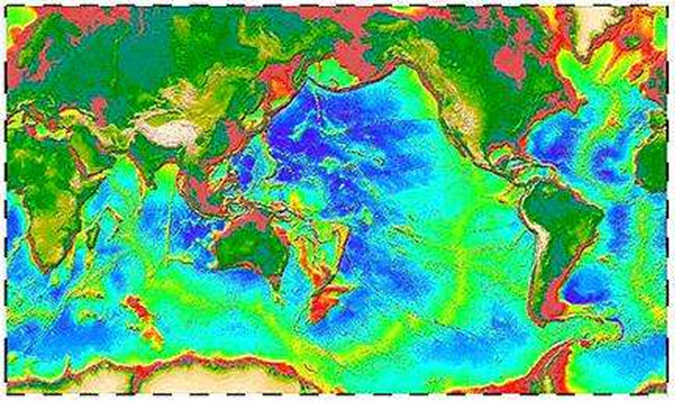
continental margin – is the area between the continent and the ocean basin (Atlantic type – it consists of the continental self, slope and foothills; Andean type – a narrow continental shelf and an oceanic trench immediately below the continental slope; island arc type – consists of a volcanic island arc with an oceanic trench),
Oceans – deep-sea pools have a depth of approx. 6 km, in trenches 9 km and exceptionally up to 11 km; similar to continental mountain ranges in the ocean are its ridges with an elevation of about 3 km; in the middle of oceanic ridges there is often a depression, so-called rifts; elevated places compared to deep-sea basins are the so-called continental foothills; furthermore, in the oceans there are already mentioned trenches, adjacent island arcs, volcanoes and volcanic ridges (see picture),
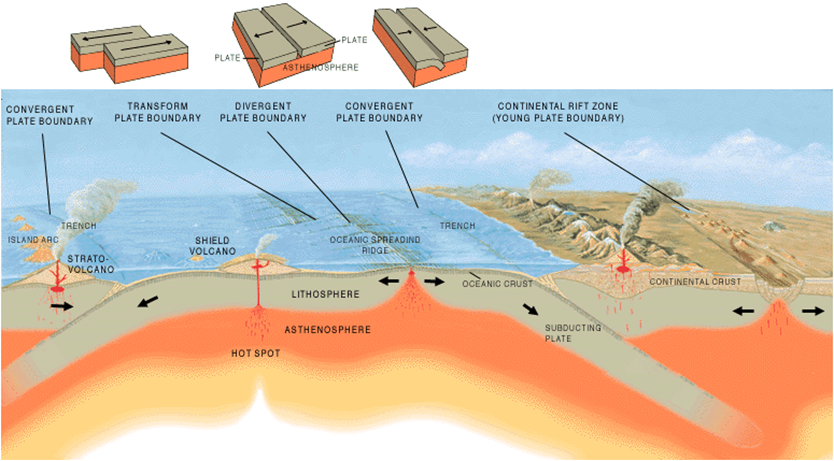
Distribution of volcanoes on Earth. 75% of current or historically active volcanoes lie along the circum-Pacific belt (the so-called ring of fire). It includes the young mountain ranges of western America and the volcanic island arcs lining the northern and western sides of the Pacific. The second belt is the Mediterranean-Asian belt; here, volcanic activity is much less frequent, with the exception of Indonesia with the Mediterranean. We mentioned oceanic volcanic belts above.
It should be noted that volcanic activity is also linked to rift systems (both in the oceans and on the continent). It has been proven that 93% of all active volcanoes lie along circles that would cut 3 mutually perpendicular planes through the center of the Earth.
Distribution of seismic activity:
1. Shallow earthquakes with foci up to a depth of 70 km.
2. Medium deep with foci between 70 – 300 km.
3. Deep earthquakes with foci between 300 – 700 km deep.
In the circum-Pacific belt lies 80% of all shallow, 90% of medium and almost all deep earthquakes. The remaining earthquakes occur in the Mediterranean-Asian belt and in the world rift system.
Seismology and the Earth’s interior
Seismology studies earthquakes, both natural and man-made. We also briefly dealt with seismology in the previous article Geophysics (kint.cz)
Seismic waves pass through the Earth’s body and return to the surface with information about the physical properties of the Earth’s interior. The disadvantage of natural earthquakes is that we do not know the moment or place of their origin. Underground nuclear explosions do not have this disadvantage 1POSPÍŠIL, Lubomil. Geofyzika a geodynamika. Modul #1, Studijní opory pro studijní programy s kombinovanou formou studia. Brno: VUT v Brně Fakulta stavební 2007..
Since the speed of seismic waves depends, among other things, on density, basic considerations can be made about the distribution of densities in the Earth. The Earth is densely inhomogeneous with densities in its interior greater than 5.5 gcm-3. Another information about the distribution of masses inside the Earth is provided by the moment of inertia.
The Earth’s moment of inertia is found to be 0.331 MR2 (where M is the mass and R is the Earth’s radius), which implies that the Earth’s mass is more concentrated around its center, and that the densities at the center of the Earth are higher than average.
Seismic rays must therefore travel through the Earth in curved paths, bouncing off various seismic interfaces. The energy released in an earthquake or nuclear explosion is transformed into various seismic waves. Volume longitudinal waves P have twice the speed of volume waves transverse and S. Surface waves L are also significantly applied on Earth, which are again of two types.
Rayleigh surface waves are kind of like longitudinal waves, while Love waves correspond to transverse waves. The energy of long-wavelength waves penetrates deeper and faster than short-wavelength waves 2POSPÍŠIL, Lubomil. Geofyzika a geodynamika. Modul #1, Studijní opory pro studijní programy s kombinovanou formou studia. Brno: VUT v Brně Fakulta stavební 2007..
The course of the Earth’s seismic rays can be seen in the next figure, also showing Bullen’s model of the Earth, having three main parts: the upper mantle, mantle and core; each part has its own further subdivisions. Today, the division of the mantle into lithosphere and asthenosphere is more widely used. The upper part of the lithosphere is the earth’s crust 3POSPÍŠIL, Lubomil. Geofyzika a geodynamika. Modul #1, Studijní opory pro studijní programy s kombinovanou formou studia. Brno: VUT v Brně Fakulta stavební 2007..
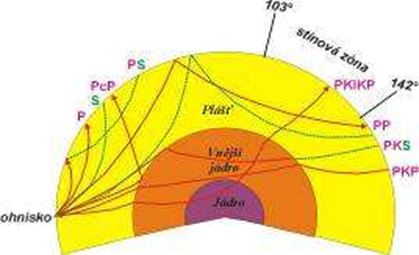
Seismic rays, emanating from the focus, curve in depth. S rays are more curved than P. S rays end – do not pass through the core, or they only reflect from it. This is because the core behaves like a liquid, which is manifested in the fact that it does not transmit S waves 4POSPÍŠIL, Lubomil. Geofyzika a geodynamika. Modul #1, Studijní opory pro studijní programy s kombinovanou formou studia. Brno: VUT v Brně Fakulta stavební 2007..
The most prominent interface is the outer restriction of the core. The Earth’s core was discovered by Guttenberg using “seismic shadow” observations. If, for example, the epicenter of the earthquake lay to the west, then P waves could be registered on the entire globe with the exception of the belt in the southern hemisphere between already. earth latitude 103° to 142° where P waves are very weak.
This is due to the fact that the P ray, which passes tangentially past the core, falls at 142°, while the ray immediately adjacent to it already breaks into the core and comes to the surface in the shadow zone5POSPÍŠIL, Lubomil. Geofyzika a geodynamika. Modul #1, Studijní opory pro studijní programy s kombinovanou formou studia. Brno: VUT v Brně Fakulta stavební 2007..
By studying the arrival times of seismic waves, especially nuclear explosions, at different distances from the epicenter, hodochrons could be constructed and the dependence of seismic wave speeds on depth determined from their slopes. In places where the velocities change with a jump, the boundary of the Bullen model of the Earth lies 6POSPÍŠIL, Lubomil. Geofyzika a geodynamika. Modul #1, Studijní opory pro studijní programy s kombinovanou formou studia. Brno: VUT v Brně Fakulta stavební 2007. (see the figure).
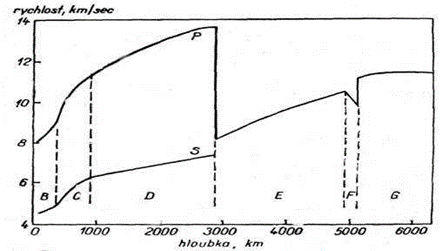
Bullen’s Earth model was also used to calculate other physical parameters: pressure, temperature (2,000 to 6,500 °C in the center of the earth).
From the point of view of the structural development of the Earth, the lithosphere (i.e. the Earth’s crust and upper mantle) is of greatest importance. The interface between them is the Mohorovičić discontinuity (MOHO), on which the speed of seismic waves increases with a jump.
Earth’s crust – has a very different strength and composition. Under the continents it consists of a layer of granitic and basalt; the interface between them is Conrad’s discontinuity, the meaning and proof of which is ambiguous. The average thickness of the crust is 35 km.
Under the oceans there is only a basalt layer and the average thickness of the crust is only 5 km. The MOHO is the boundary at which the chemical composition of rocks or their phase state, their density and the speed of seismic waves change 8POSPÍŠIL, Lubomil. Geofyzika a geodynamika. Modul #1, Studijní opory pro studijní programy s kombinovanou formou studia. Brno: VUT v Brně Fakulta stavební 2007..
The upper mantle is not homogeneous in the horizontal direction (i.e. the directions of the Pn velocity). However, even more significant changes are in the vertical direction, where there is a low-velocity layer. According to some authors, there are even 4 low-velocity layers to a depth of 700 km.) 9POSPÍŠIL, Lubomil. Geofyzika a geodynamika. Modul #1, Studijní opory pro studijní programy s kombinovanou formou studia. Brno: VUT v Brně Fakulta stavební 2007..
Based on research and according to the source mentioned above, the low-speed layer can be characterized as follows:
- It lies at a depth of 60-250 km and its boundary is not sharp.
- It goes around the whole earth.
- Seismic waves are slowed down more under oceans than under continents. The low-velocity layer lies beneath the oceans closer to the Earth’s surface than beneath the continents. Further evidence that differences between the oceanic and continental regions are not limited to the Earth’s crust in the MOHO.
- S waves of shorter wavelengths are absorbed. This means that the rocks in the low-velocity layer are in an almost plastic state, which seems to indicate that they have temperatures close to the melting point.
- Volcanoes are mostly in places where there are earthquakes. Earthquakes that are related to volcanism are mostly from depths of 60-200 km. This means that the volcanic activity is associated with faults in the low-velocity layer, which is apparently the source of the primary basaltic magma.
- However, most earthquakes lie below a depth of 60 km, or at greater depths the material is already more plastic, so that anomalous stresses can be largely balanced by “rubbing” of the material.
The earth’s crust and part of the upper mantle down to the low-velocity layer collectively called the lithosphere (lithos – Greek stone) are made up of rigid rocks. Beneath the lithosphere lies the asthenosphere (asthenos- Greek for soft); it is characterized by plastic rocks; it includes the entire low-speed layer; the lower limit is quite different according to different authors.
The low-velocity layer is of fundamental importance for the interpretation of isostasy, tectonics, mountain-forming processes, continents. drift, tectonics of lithospheric blocks (plate tectonics).
Physical properties of the Earth
Geodynamics deals with other physical properties of the earth, particularly the following: the distribution of densities within the earth; elastic properties such as pressure and gravitational acceleration (can be derived from seismic wave velocities and density distribution within the Earth); temperature in the earth.
Earth temperatures
The current thermal state of the Earth results from its thermal history, about which a number of hypotheses have been expressed, which are based on certain assumptions about the origin and early history of the Earth, the chemical composition and physical properties of the matter of which the Earth is composed 10POSPÍŠIL, Lubomil. Geofyzika a geodynamika. Modul #1, Studijní opory pro studijní programy s kombinovanou formou studia. Brno: VUT v Brně Fakulta stavební 2007..
Geotherm expresses the relationship between depth and temperature in the Earth. The following are assumed to be sources of internal heat:
gravitational energy that was transformed into heat during the formation of the Earth’s core,
the energy created by friction during earth tides or subduction is transformed into thermal energy, probably in weakened zones, such as, for example, the low-velocity layer, subduction zones,
thermal energy generated during the decay of radioactive elements. It is probably the main source, maintaining the external thermal state of the Earth and the current heat flow:
– heat flow from the Earth’s interior (conduction, radiation, convection); its depth measurement,
– depth temperature ratios (thermal conductivity k(z), distribution of heat sources A(z),
– earth surface temperatures see pictures,
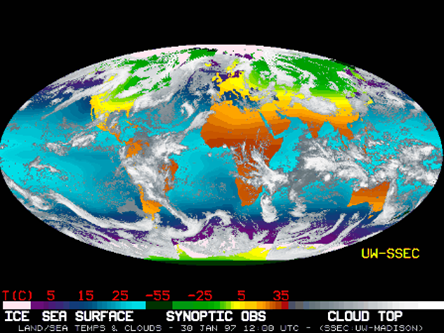
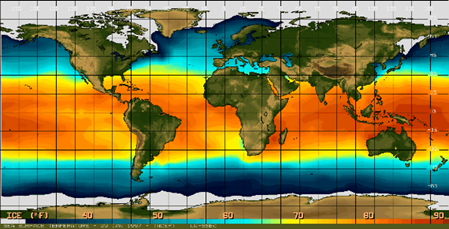
– the viscosity of the individual layers of the Earth is known only very approximately; it is of particular interest to us that a number of observations indicate that a low-viscosity layer exists in the upper mantle at depths corresponding to the low-velocity layer 11POSPÍŠIL, Lubomil. Geofyzika a geodynamika. Modul #1, Studijní opory pro studijní programy s kombinovanou formou studia. Brno: VUT v Brně Fakulta stavební 2007.,
– Earth’s magnetic field – magnetic field lines have a vertical direction in magnetic poles whose position changes over time (currently in northern Canada and Antarctica, their connecting line does not pass through the center of the Earth);
the cause of the field is 94% inside the Earth, the rest is emitted by external sources; the field can be expressed as the effect of a series of magnetic dipoles at the center of the Earth, having different orientations;
the first of these dipoles represents a substantial part of the Earth’s regular field, it is the so-called tilted geocentric dipole, whose axis forms an angle of 11.5° with the Earth’s axis of rotation and intersects the Earth at the geomagnetic poles;
short-term periodic variations of the magnetic field (on the order of hours, days and years) can be explained using electric currents in the mantle and ionosphere; changes in intensity reach the order of 10 to 100 nT,
– magnetic storms – are short-term, irregular fluctuations that can exceed the value of 103 nT; they arise in the ionosphere due to anomalous bombardment by solar radiation, mainly during the occurrence of sunspots 12POSPÍŠIL, Lubomil. Geofyzika a geodynamika. Modul #1, Studijní opory pro studijní programy s kombinovanou formou studia. Brno: VUT v Brně Fakulta stavební 2007., see picture,
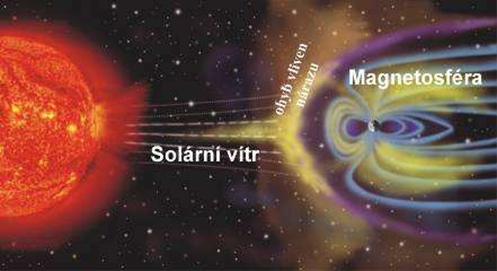
– secular changes are manifested in declination, inclination and intensities. Secular variations in intensities have values of units to tens of nT per year (isopore maps); cyclical changes in the direction of the field have a period of several hundred years and cause deviations of 10 to 20 ° to both sides from the average direction,
– Earth’s magnetic moment varies secularly; shrunk by 5% in 100 years; however, it seems rather that the magnitude of the moment oscillates around a certain value,
– paleomagnetism studies both fossil and remanent magnetism; pole wandering, magnetic inversions correlated with linear magnetic anomalies are among the most important evidences for continental drift,
– Earth’s gravitational field – the masses of the Earth cause gravitational acceleration, rotation centrifugal acceleration; we refer to the vector sum of both accelerations as gravitational acceleration and weight; The Earth’s rotation has caused the Earth to be flattened at the poles; gravitational acceleration is a function of latitude – it is greatest at the poles, smallest at the equator;
– gravity anomalies – from free air (surpluses or shortages of mass inside the Earth compared to the normal distribution of masses that corresponds to normal gravity);
Complete Bouguer anomalies express the effect of masses with anomalous density (ie density different from the average);
these masses lie mainly in the upper part of the lirosphere – it was found that complete Bouguer anomalies are negative in high areas, on the other hand, they are positive in ocean spaces;
isostatic anomalies – a zero anomaly means that the block is in hydrostatic equilibrium, a negative anomaly means that the block has too deep roots (Airy) or too low average density (the block is hydrostatically pushed up and if there are no other larger forces acting in the opposite direction, then the block rises), positive isostatic anomalies, on the other hand, express a tendency to fall.
Geological cycle and age of rocks
There are two sources of energy that set geological processes in motion: the Earth’s internal heat and solar radiation. The internal source supplies energy for the formation of igneous rocks, metamorphic and tectonic processes. An external source (the Sun) cycles the atmosphere and hydrosphere, ventilation, erosion and the formation of sedimentary rocks. Geochemical processes also play an important role.
The interconnection of all processes is expressed by the geological cycle (Figure 32), which is not closed. Magma, which forms in the mantle at a depth of around 50 km or more, rises to the surface, where it is enriched with additional material containing silicates, which allows the formation of new rocks in the earth’s crust.
At the same time, water and other gaseous components are released. From this it can be concluded that the earth’s crust, hydrosphere and atmosphere were formed gradually as a result of repeated magmatic activity. 13POSPÍŠIL, Lubomil. Geofyzika a geodynamika. Modul #1, Studijní opory pro studijní programy s kombinovanou formou studia. Brno: VUT v Brně Fakulta stavební 2007.
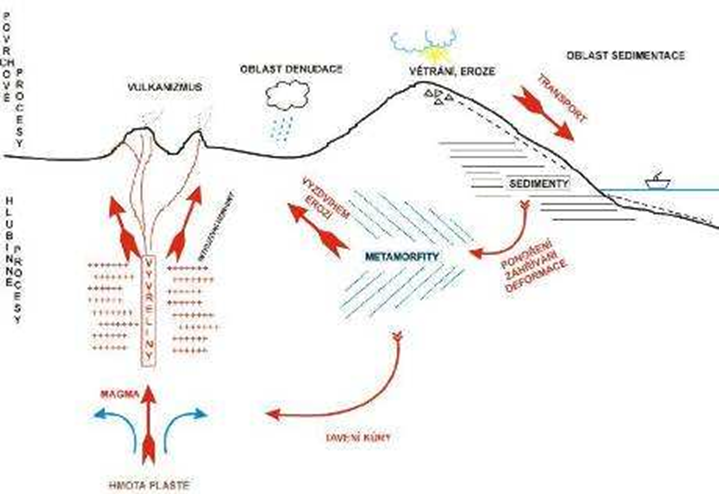
We determine the age of rocks either by paleontological methods based on fossils or by radioactive methods and, most recently, by using paleomagnetism.
Lithosphere
The rheological behavior of the lithosphere and asthenosphere is described by viscosity and the law of the loss of deformation with time. A liquid heated from the inside or from below performs convective motion if the Rayleigh number exceeds a critical limit.
The Rayleigh number for the shell is significantly larger than the critical threshold for triggering convection. Thermal convection with a very high Rayleigh number is characterized by the existence of a thin thermal layer, which is the lithosphere.
From that point of view, the lithosphere is the thermal diffusion layer of the mantle convection system. This means that it is not very stable and the temperature distribution is determined by heat conduction, while in the mantle the temperatures are close to adiabatic temperatures. 14POSPÍŠIL, Lubomil. Geofyzika a geodynamika. Modul #1, Studijní opory pro studijní programy s kombinovanou formou studia. Brno: VUT v Brně Fakulta stavební 2007.
In the case of the lithosphere, we mainly monitor its vertical and horizontal movements, spreading of the sea floor (spreading), mid-ocean ridges and rifts, convection and rotation, convection in the mantle and gravity field (tectonic activity), MOHO vz. The Earth’s crust, the interface between the lithosphere and the asthenosphere. The mentioned areas are described in more detail in the thesis 15POSPÍŠIL, Lubomil. Geofyzika a geodynamika. Modul #1, Studijní opory pro studijní programy s kombinovanou formou studia. Brno: VUT v Brně Fakulta stavební 2007..
Continental drift
Paleomagnetism yields drift data. Appropriately selected rock samples of different ages show that the direction of their remanent magnetization is different than if they were magnetized in today’s Earth’s magnetic field.
The direction to the geomagnetic pole can also be determined from the direction of the remanent magnetization vector. From the given data, it is therefore possible to reconstruct the positions of the paleopoles for individual geological periods in relation to the present-day geographical network. Pole shift can be caused by:
1. By the movement of parts or the entire earth’s crust in the unchanging position of the magnetic pole (or the unchanging axis of the Earth’s rotation.
2. By moving the magnetic pole relative to the fixed position of the earth’s crust.
Currently, the results of paleomagnetic measurements are more often displayed by drawing paleomagnetic poles into the current graphic network with continents, which we connect with a continuous line, so that it can be seen how their position has changed.16POSPÍŠIL, Lubomil. Geofyzika a geodynamika. Modul #1, Studijní opory pro studijní programy s kombinovanou formou studia. Brno: VUT v Brně Fakulta stavební 2007.
The picture shows paleomagnetic vectors of Cretaceous to Miocene rocks in the Carpathian area.
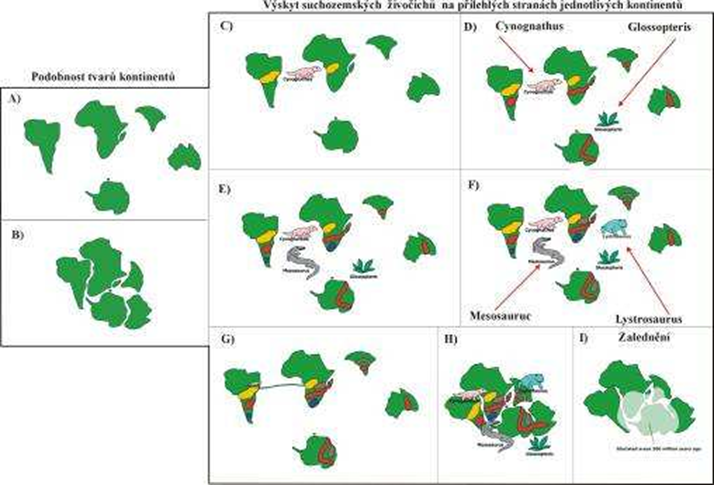
Lithospheric plate tectonics
The theories of continental drift and seafloor spreading were the cornerstones for the concept of plate tectonics, which is a new global tectonics.
This theory assumes that the surface part of the Earth consists of several rigid blocks that are in relative motion to each other (see figure). The blocks reach a depth of around 100 km and slide along the asthenosphere. 17POSPÍŠIL, Lubomil. Geofyzika a geodynamika. Modul #1, Studijní opory pro studijní programy s kombinovanou formou studia. Brno: VUT v Brně Fakulta stavební 2007..
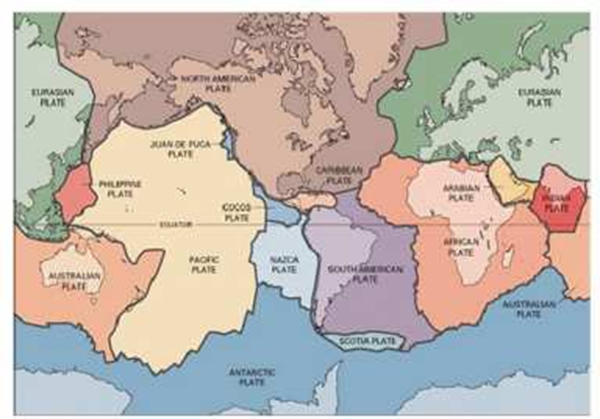
The boundaries of the lithospheric plates were determined according to the belts of increased seismicity. There are three basic types of boundaries a) Extensional (divergent) boundaries on which the normal components of the forces acting on the plates point away from the boundary, b) Compressional (convergent) – the normal components of the forces point towards the boundary. Along the extensional boundary, new oceanic lithosphere is formed symmetrically on both sides, while along the convergent boundaries the lithosphere sinks asymmetrically into the mantle (subduction).
This type of border is usually accompanied by oceanic trenches, the formation of island arcs and tectonic activity of the edge of the continent (e.g. the Alpine-Himalayan mountain belt). c) The third type of boundary is transform breaks. Their discovery is one of the important results of the research of magnetic anomalies in the northeastern part of the Pacific Ocean. The interpretation was given by J. T. Wilson; defined 10 types of transform fractures. 18POSPÍŠIL, Lubomil. Geofyzika a geodynamika. Modul #1, Studijní opory pro studijní programy s kombinovanou formou studia. Brno: VUT v Brně Fakulta stavební 2007..
In relation to safety/security
Geodynamics provides a lot of important information in relation to safety, because the design and construction of safety-critical objects, systems, elements, etc., is based on certain input conditions taking into account the surrounding operating conditions at a given time. The mentioned operating conditions change over time and, what’s more, sometimes phenomena occur that significantly exceed the given design limits of the objects (geomagnetic storms, earthquakes, unstable subsoil of buildings, liquefaction of subsoil, gushing of gases from the ground, volcanic activity – dust, floods caused by geodynamic phenomena of the Earth, etc. .). Geodynamics helps us understand these events and consider their threats and risks.
